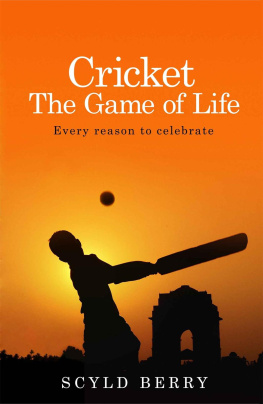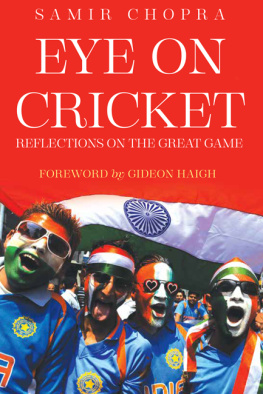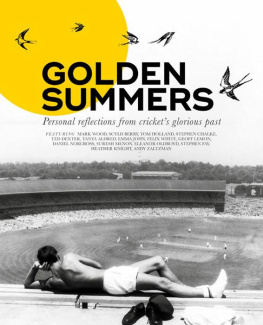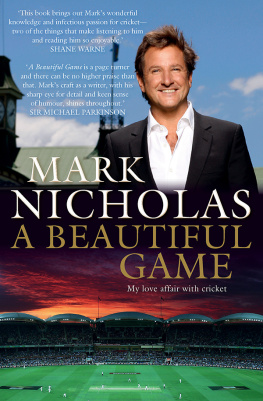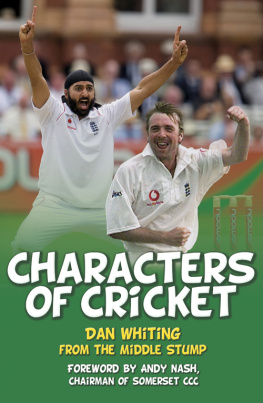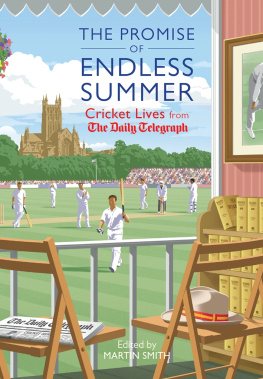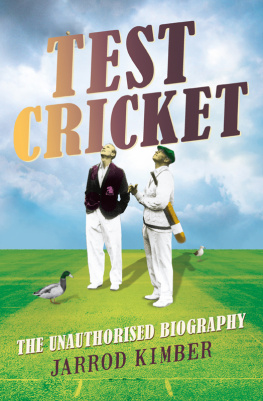Cricket: The Game of Life
Scyld Berry

www.hodder.co.uk
First published in Great Britain in 2015 by Hodder & Stoughton
An Hachette UK company
Copyright Scyld Berry 2015
The right of Scyld Berry to be identified as the Author of the Work
has been asserted by him in accordance with the Copyright,
Designs and Patents Act 1988.
All rights reserved. No part of this publication may be reproduced,
stored in a retrieval system, or transmitted, in any form or by any
means without the prior written permission of the publisher, nor be
otherwise circulated in any form of binding or cover other than that
in which it is published and without a similar condition being
imposed on the subsequent purchaser.
A CIP catalogue record for this title is available from the British Library
ISBN 978 1 473 61857 2
Hodder & Stoughton Ltd
Carmelite House
50 Victoria Embankment
London EC4Y 0DZ
www.hodder.co.uk
To the members of Hinton Charterhouse Cricket Club,
especially those who have made catches and stumpings off my bowling, but above all the groundsmen.
Contents
A Net
Out of the shipping container in Basra came a succession of strange noises. Thud. Thud. Thud. It had been converted into makeshift quarters for a British Army officer after the invasion of Iraq in 2003. To be more serviceable, if not homely, the containers steel walls had been plastered on the inside.
Nobody had heard this thudding through the night of shelling, when rocket-propelled grenades and screaming mortars tore into buildings and vehicles. It had been one of those intensely humid nights beside the Shatt al-Arab, the confluence of the Tigris and the Euphrates, when the moment you walk outside an air-conditioned room, a skein of sweat covers your skin. In the morning, in any event, the officer was absent from his desk at headquarters.
When his colleagues and the Military Police went to see why the officer was not on duty, and heard this thudding coming from the container, they found it locked on the inside. They had to break the steel door.
Inside, the officer was wide awake. He was not wearing the khaki helmet that was mandatory for officers when they were out of bed, in case of sudden attack by a Shiite militia. He was wearing a pair of underpants. On his head. Nothing else.
The thudding, they soon established, was intended to drown out the explosions. The officer had succumbed to post-traumatic stress disorder. To cope with a war remote from home, and reason, he had sought solace in the pastime of his childhood. Naked except for his improvised helmet, he was hitting a ball against the inside wall of the container with his cricket bat.

I came from Sheffield. Somebody had to, as Bill Bryson said of his birthplace, Des Moines. But in terms of watching cricket I was very lucky to be born less than a mile from Bramall Lane. It was the best ground in the world according to some cricketers, and not only those from Yorkshire.
Jack Fingleton, who opened the batting at Bramall Lane for the Australians in 1938 and became an eminent journalist, declared it had the keenest cricketing crowd in England. Jeff Stollmeyer of Trinidad, who captained West Indies, observed: There is more atmosphere at Bramall Lane than at any other cricket ground on which I have played, except Lords. It was an atmosphere vastly different to Lords, tense and full of the spirit of combat, accentuated as it was by the squat chimneys looming black outside the ground. When the West Indians of 1950, including Stollmeyer, narrowly won their match against Yorkshire, the crowd of 30,000 threw their seat cushions on to the field in disgust. The ground had drawn crowds of double that size for England football internationals and for an FA Cup final replay, when everybody stood.
Bramall Lanes colours were primary bright. As Stollmeyer saw, the Lane itself was as black as the soot from steel factories and foundries that rained on the city. Stoke up the boilers, lads! was reputed to be the cry when word went round that Yorkshire were bowling, to hamper the batsmens vision.
St Marys church, at the head of the Lane, was coal-black from the tip of its spire down to the smashed windows. Whenever my mother and I walked to a match, we never went inside the church. That awe which every child is said to need could be found at Bramall Lane.
As we passed St Marys, and the terraces of two-up two-downs, with corner shops advertising Craven A and Tizer, the blue lettering of Yorkshire became clearer on the posters on the blackened stone walls of the ground the red of their opponents in smaller lettering below. Clutching my two shillings and sixpence, I might have run ahead to the turnstiles. Yorkshire staged four first-class matches a season at Bramall Lane, often three in the Championship and one against the touring team.
After pushing through the turnstiles, I rush up the steps to the top of the terraces and down the other side to get below the roof-line of the stand.
The crash barriers, after the football season, are freshly painted red.
The sightscreens are bright white, like few things in Sheffield before the Clean Air Act.
The field is luscious green, especially where the cricket outfield overlaps the football pitch.
Scoring card, get the official card! shout men in coats that once might have been white as they stride up and down the terraces not that I ever see a rival selling unofficial cards. Cards at sixpence each! They record the ascendancy of a county that has never been equalled. In the 1960s, not only were Yorkshire county champions for seven years; they also beat the Australians by an innings, the Indians by an innings and the New Zealanders by an innings, all at Bramall Lane, and the West Indians by 111 runs at Middlesbrough. Australian tourists called their match against Yorkshire the sixth Test. During the 1960s, so I believed, Yorkshire at home were the strongest cricket team in the world.
Brian Close is Yorkshires captain and man-manager, and perhaps the bravest man who ever faced fast bowling or stood unhelmeted at short-leg. Raymond Illingworth, soon to become Englands foxiest captain, is in charge of tactics. (Not for another 40 years, until the Ashes series of 2005, did I see such error-free cricket from an English team again.)
Fred Trueman opens the bowling with a perfect side-on action; Jimmy Binks keeps wicket as a butler takes care of the silver; Phil Sharpe conjures at first slip; Ken Taylor is swift or Geoffrey Boycott safe in the covers; John Hampshire bends at short-leg to scoop up catches with a blacksmiths forearms. Bramall Lanes pitches are ideal for three-day cricket: damp and seaming on the first morning, excellent for batting on the second day, spinning on the third afternoon.
The only fly in the ointment is the yeasty smell from Wards brewery beside St Marys if the wind blows in the wrong direction. Nothing else detracts from the raw drama on this green ground in the heart of an industrial city.
After tea, a waterfall flows down the terraces when the gates are opened and spectators are allowed in for free, mixing with the thousands intent on the action. The Grinders Stand, its back to the Lane, is renowned as the most knowledgeable stand in cricket. Not that we dare to sit on those wooden benches: my mother and I sit on the terraces on the opposite side, on cushions hired for twopence, without throwing them.
On these summer afternoons when Yorkshire move towards another Championship, generators hum in the factories outside the ground. The only time I am nearly so happy is when my mother takes me to pick bilberries on the moors above Sheffield and we have a picnic beside a stream. But Bramall Lane is where I am most alive. This hum is the hum of my universe.
Next page
